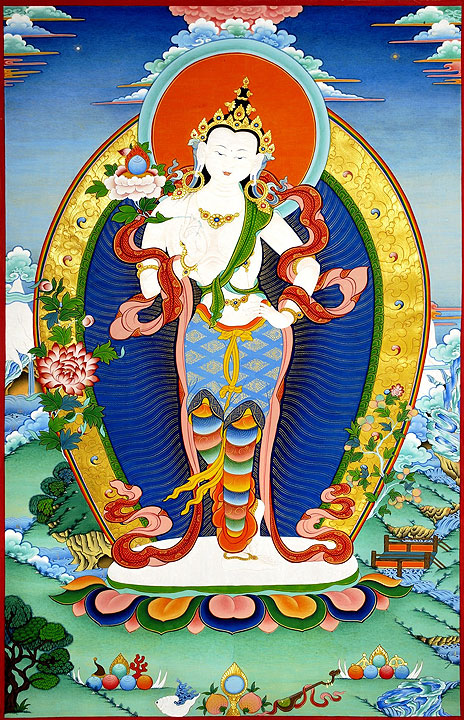A Buddhist painter from Old Saybrook, CT
 Jampa was born in 1959 just after his parents arrived in India, having left their farmland in Shigatse near Lhasa. Settling in Darjeeling, the family was visited by a monk-painter who noticed Jampa’s talent. After school each day from the age of thirteen Jampa took art lessons from his teacher, Ngawang Norbu. Later Jampa moved south to Mysore to become an apprentice to his famous painter at the Gyudmed Tantric University, studying techniques of thangka painting for five years. The bond between master teacher and student can become very strong, almost familial. Jampa worked with his teacher, who also lived with the family, for the next fifteen years. Together they accepted commissions for thangka paintings, murals, and restoration of old art works. Their most important project took four painters nearly four years to complete—recreating forty-one thangkas in the Dalai Lama’s collection, each 4 feet by 3 feet, depicting the past lives of the Buddha.
Jampa was born in 1959 just after his parents arrived in India, having left their farmland in Shigatse near Lhasa. Settling in Darjeeling, the family was visited by a monk-painter who noticed Jampa’s talent. After school each day from the age of thirteen Jampa took art lessons from his teacher, Ngawang Norbu. Later Jampa moved south to Mysore to become an apprentice to his famous painter at the Gyudmed Tantric University, studying techniques of thangka painting for five years. The bond between master teacher and student can become very strong, almost familial. Jampa worked with his teacher, who also lived with the family, for the next fifteen years. Together they accepted commissions for thangka paintings, murals, and restoration of old art works. Their most important project took four painters nearly four years to complete—recreating forty-one thangkas in the Dalai Lama’s collection, each 4 feet by 3 feet, depicting the past lives of the Buddha.
Religious painting holds great importance in Tibetan Buddhism. Vast stores of Buddhist knowledge and doctrine are written in books housed in monasteries. Paintings both large and small illustrate these texts by depicting central figures and deities, stories of their lives, as well as charts of medical knowledge and elements of doctrine. Tibetan Tantric Buddhism practices visualization as a way to transform the self, to “identify with” Buddha and other deities, and to work toward enlightenment by bringing principles of wisdom and compassion into one’s life. By viewing and meditating deeply upon a painting, one’s own character can become imbued with the qualities of the figure represented. Both lay people and lamas commission paintings for devotional purposes as well as for aiding health or for teaching Buddhist doctrine.
The usual form of such painting in Tibet is the thangka, a painted scroll which can be rolled up for storage or transport. Thangka painting’s origins and influences are complex, going back to 7th century India, with evolution over the centuries affected by Nepali and Chinese styles. Painting methods have also developed over hundreds of years, and are strictly followed by artists. Jampa’s training included techniques of canvas preparation, mixing pigments, measurement, outlining and drawing of the design, painting, shading, finishing, and mounting. The exquisite care and skill needed to create an authentic thangka make the costs of commissioning one very high. According to religious tradition, thangkas should not be made and sold in a market. Today, however, this does happen. In America, the difficulty of obtaining the right materials, as well as finding time to devote to such labor-intensive art, has been a challenge for Jampa and other artists.
The process of creating a thangka requires several steps. First a piece of pure cotton is hemmed on all sides then stitched to four bamboo sticks, making a flexible frame. These sticks are attached by strong thread to a larger wooden frame which holds the cloth taut and stretches it when the thread is pulled. An animal hide glue is applied to both sides of the cloth, scraping to make sure no particles remain on the surface. After the cloth is stretched and dried, one or two coats of chalk or clay gesso are applied. Jampa then rubs the smooth side of a conch shell over it to press the gesso into the “holes” in the cotton, making the surface like paper.
Next, measurements and calculations determine the exact center to create an axis on the canvas for the drawing. An experienced artist like Jampa can draw the design freehand; sometimes for complicated figures a tracing is made from a book or master draftsman’s work. Qualities and proportions of all the deities are set out in exquisitely detailed iconographies within Buddhist texts—the artist does not alter these. After the sketch is outlined in ink, painting begins by applying base colors one at a time. Pigments are natural minerals crushed and mixed with water and herbs, sometimes with a little glue. A variety of shading and toning techniques are used very carefully and subtly throughout the painting. Outlining details are added as well as facial features. Twenty-four carat gold paint is usually applied for patterns on clothes or ornaments, then burnished. The completed thangka is often encased in a silk brocade frame backed by muslin, with bamboo and cedar dowels at top and bottom for hanging or rolling up. Thangkas used in religious ceremonies are consecrated by a lama.
